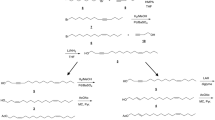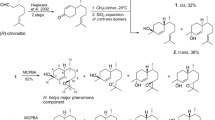Abstract
field attraction test of (7R,8S)-cis-7,8-epoxy-2-methyloctadec-17-ene (= 7R,8S-epo-2me-17ene-18Hy), a trace component of the sex pheromone gland of the Asian gypsy moth, (Lymantria dispar), traps that were baited with the trace component attracted more L. dispar than traps baited with (7S,8R)-cis-7,8-epoxy-2-methyloctadec-17-ene (= 7S,8R-epo-2me-17ene-18Hy) and unbaited traps. However, traps baited with 7R,8S-epo-2me-17ene-18Hy were less attractive than traps baited with (+)-disparlure [= (7R,8S)-cis-7,8-epoxy-2-methyloctadecane], the sex pheromone of L. dispar. Combination tests with (+)-disparlure, 7R,8S-epo-2me-17ene-18Hy, and 7S,8R-epo-2me-17ene-18Hy revealed that 7R,8S-epo-2me-17ene-18Hy acted synergistically with (+)-disparlure.



Similar content being viewed by others
References
Bierl BA, Beroza M, Collier CW (1970) Potent sex attractant of the gypsy moth, Porthetria dispar (L.): its isolation, identification, and synthesis. Science 170:87–89
Bierl BA, Beroza M, Collier CW (1972) Isolation, identification, and synthesis of the gypsy moth sex attractant. J Econ Entomol 65:659–664
Bogdanowicz SM, Wallner WE, Bell J, Odell TM, Harrison RG (1993) Asian gypsy moths (Lepidoptera: Lymantriidae) in North America: evidence from molecular data. Ann Entomol Soc Am 86:710–715
Bogdanowicz SM, Mastro VC, Prasher DC, Harrison RG (1997) Microsatellite DNA variation among Asian and North American gypsy moth (Lepidoptera: Lymantriidae). Ann Entomol Soc Am 90:768–775
Boo KS (1998) Variation in sex pheromone composition of a few selected lepidopteran species. J Asia Pac Entomol 1:17–23
Boo KS, Jung CH (1998) Field tests of synthetic sex pheromone of the apple leafminer moth, Phyllonorycter ringoniella. J Chem Ecol 24:1939–1947
Boo KS, Park JW (1998) Sex pheromone composition of the Asian corn borer moth, Ostrinia furnacalis (Guenée) (Lepidoptera: Pyralidae) in South Korea. J Asia Pac Entomol 1:77–84
Boo KS, Park KC (2005) Insect semiochemical research in Kora: overview and prospects. Appl Entomol Zool 40:13–29
Chen F, Luo Y, Keena MA, Wu Y, Wu P, Shi J (2016) DNA barcoding of gypsy moth from China (Lepidoptera: Erebidae) reveals new haplotypes and divergence patterns within gypsy moth subspecies. J Econ Entomol 109:366–374
Gries G, Schaefer PW, Gries R, Liška J, Gotoh T (2001) Reproductive character displacement Lymantria monacha from Northern Japan? J Chem Ecol 27:1163–1176
Gries R, Khaskin G, Schaefer PW, Hahn R, Gotoh T, Gries G (2005) (7R,8S)-cis-7,8-epoxy-2methyloctadec-17ene: a novel trace component from the sex pheromone gland of gypsy moth, Lymantria dispar. J Chem Ecol 31:49–62
Iwaizumi R, Arakawa K, Koshio C (2010) Nocturnal flight activities of the female Asian gypsy moth, Lymantria dispar (Linnaeus) (Lepidoptera: Lymantriidae). Appl Entomol Zool 45:121–128
Lee BY, Chung YJ (1997) Insect pests of trees and shurubs in Korea. Seong-An-Dang Publishing Co., Seoul, pp 84–86
Lee HP, Lee HM (1999) Seasonal occurrence and monitoring of gypsy moth, Lymantria dispar L. (Lepidoptera: Lymantriidae) by sex pheromone trap in Mt. Namsan, Seoul. Korean J Ecol 22:299–303
Leonard DE (1974) Recent developments in ecology and control of the gypsy moth. Annu Rev Entomol 19:197–229
Pfeifer TA, Humble LM, Ring M, Grigliatti TA (1995) Characterization of gypsy moth populations and related species using a nuclear DNA marker. Can Entomol 127:49–58
Reineke A, Zebitz CPW (1999) Suitability of polymerase chain reaction-based approaches for identification of different gypsy moth (Lepidoptera: Lymantriidae) genotypes in central Europe. Ann Entomol Soc Am 92:737–741
Schreiber DE, Garner KJ, Slavicek JM (1997) Identification of three randomly amplified polymorphic DNA-polymerase chain reaction markers for distinguishing Asian and North American gypsy moths (Lepidoptera: Lymantriidae). Ann Entomol Soc Am 90:667–674
Yokochi H (2007) Current situations and issues at the export quarantine inspection consultation. Plant Prot 61:451–456
Acknowledgements
We thank Professor Gerhard Gries (Simon Fraser University, British Columbia, Canada) for supplying (+)-disparlure, 7R,8S-epo-2me-17ene-18Hy, and 7S,8R-epo-2me-17ene-18Hy.
Author information
Authors and Affiliations
Corresponding author
Additional information
Project funding: This work was carried out with the support of the “Cooperative Research Program for Agriculture Science and Technology Development (Project No. PJ01175601)” Rural Development Administration, Republic of Korea.
The online version is available at http://www.springerlink.com
Corresponding editor: Chai Ruihai.
Rights and permissions
About this article
Cite this article
Park, IK., Lee, HR., Jung, CS. et al. Synergic effect of sex pheromone (7R,8S)-cis-7,8-epoxy-2-methyloctadec-17-ene on (+)-disparlure of the Asian gypsy moth, Lymantria dispar, in Korea. J. For. Res. 30, 1119–1122 (2019). https://doi.org/10.1007/s11676-018-0668-8
Received:
Accepted:
Published:
Issue Date:
DOI: https://doi.org/10.1007/s11676-018-0668-8




